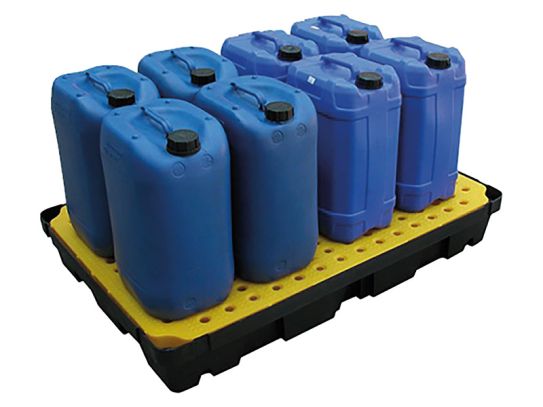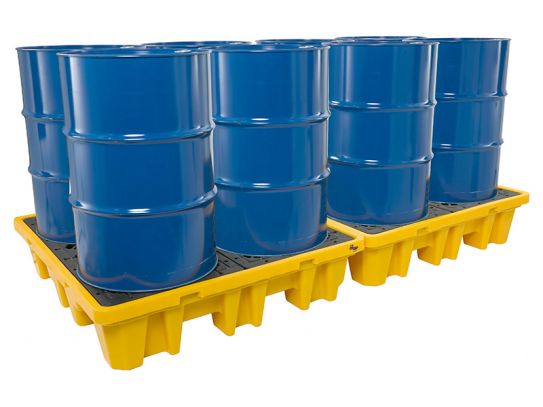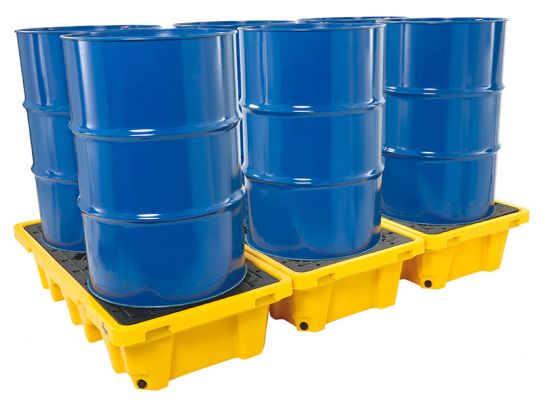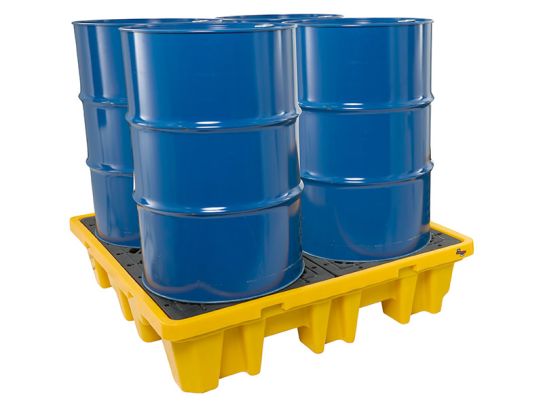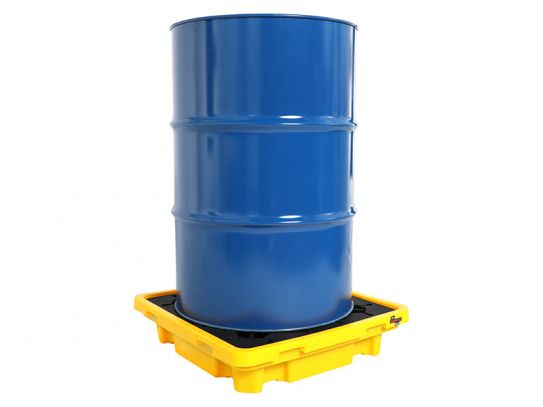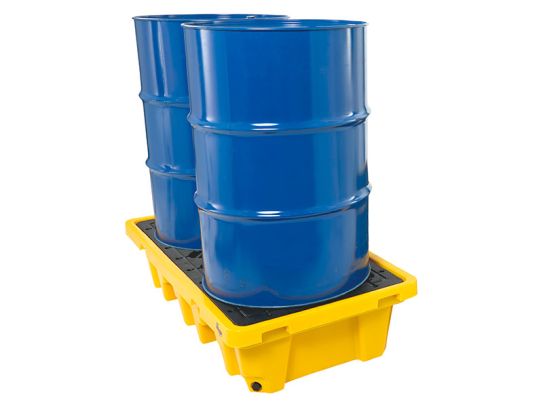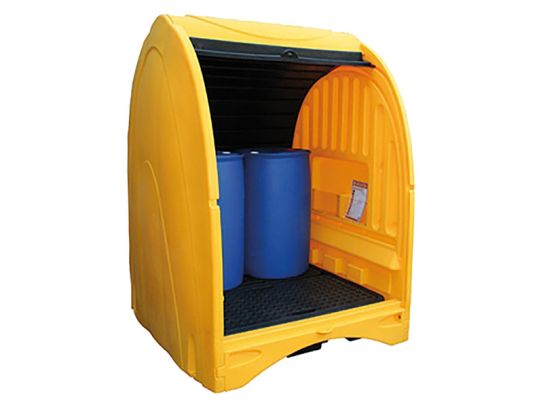Spill Pallets
Whether you need to store drums or IBCs, our spill pallets are the ideal solution. Our spill pallets come with built-in pumps and dispensing hoses for easy liquid transfer, making them perfect for loading and unloading liquids. And with their durable construction and chemical resistance, these pallets will provide years of safe and reliable service.
Safely Handle Chemicals With Our Spill Pallets
Introducing our top-of-the-line spill pallet range - your ultimate solution for safe and efficient handling of oils and chemicals. From spill trays to drum workstations and IBC spill pallets, we've got you covered. With our products, you can ensure that all spills are contained within, preventing any potential hazards in your factory or workshop. Experience peace of mind while working with liquids with our durable and reliable spill pallets. Upgrade your safety protocols today and order now!
What Are Spill Pallets?
Spill pallets are products designed to contain leaks or spills of oils and chemicals in industrial settings such as factories and workshops. They typically include spill trays, drum workstations, and IBC spill pallets. These products are used to prevent spills when transferring liquids from one source to another and are typically constructed to ensure all spills are contained within. They are an important safety measure in any facility that handles potentially harmful liquids.
What Are Some Common Uses for Spill Pallets?
Spill pallets are commonly used in a variety of industrial settings to contain spills and leaks of oils and chemicals. Some examples of common uses for spill pallets include:
- Storage and dispensing of drums and IBCs (Intermediate Bulk Containers) containing oils, chemicals, and other liquids.
- Loading and unloading of liquids from delivery trucks or railcars.
- Transferring liquids from one container to another.
- Accumulation and storage of liquids in hazardous work areas.
- Maintenance and repair work on equipment and machinery that uses or contains liquids.
- As a secondary containment for tanks and vessels storing liquids.
- In chemical manufacturing plants and oil refineries.
These are just a few examples of how spill pallets are used to contain leaks or spills and help to prevent potential hazards in the workplace.
What Are the Different Types of Spill Pallets?
There are several different types of spill pallets available, each designed to meet specific needs in various industrial settings. Some of the most common types include:
- Spill Trays: These are shallow, open-top trays that are placed under equipment or machinery to catch any leaks or spills. They can be made of various materials, including plastic, steel, or aluminium.
- Spill Pallets: These are slightly larger than spill trays and have higher sides to contain larger spills. They are often used for storing and dispensing drums or IBCs containing liquids.
- Drum Workstations: These are specialised spill pallets that are designed to hold drums and include features such as built-in pumps and dispensing hoses for easy liquid transfer.
- Drum Hardcovers: These are covers that fit over standard drums to contain any leaks or spills.
- Drum Work Floors: These are large, industrial-grade spill pallets that are designed to be used as a flooring surface in areas where drums are stored or handled.
- IBC Spill Pallets: These are designed to hold and store IBC (Intermediate Bulk Containers) and they include features such as built-in drains and removable grates for easy cleaning.
All these types of spill pallets have different features and capacities, and are designed to meet different needs and requirements in industrial settings.
What Are the Key Features to Consider When Choosing Spill Pallets?
When choosing spill pallets, there are several key features to consider to ensure that you select the right product for your needs. Some of the most important features to consider include:
- Capacity: Consider the volume of liquids that will be stored or handled in the area where the spill pallet will be used, and select a product that can accommodate that volume.
- Material: Spill pallets can be made from a variety of materials, including plastic, steel, and aluminium. Consider the chemical compatibility and durability of the material in relation to the liquids that will be stored or handled.
- Size: Consider the size of the area where the spill pallet will be used, and choose a product that will fit comfortably in that space.
- Load-bearing capacity: Consider the weight of the liquids that will be stored or handled on the spill pallet, and select a product that is rated to support that weight.
- Drainage: Consider whether the spill pallet will be used indoors or outdoors, and choose a product that has appropriate drainage features to prevent standing liquid in the event of a spill.
- Compliance: Make sure the spill pallet you choose meets the regulations and standards set by OSHA or other relevant authorities.
- Portability: If the spill pallet needs to be moved regularly, consider selecting a product with wheels or other features that make it easy to move.
By considering these key features, you can ensure that you select a spill pallet that is best suited to your needs and that will provide the level of protection and performance you require.
How Can I Determine the Right Size of Spill Pallet for My Application?
To determine the right size of spill pallet for your application, you should consider the volume of liquids that will be stored or handled in the area where the spill pallet will be used. Additionally, you should also consider the size of the area where the spill pallet will be placed.
Here are a few steps you can take to determine the right size of spill pallet for your application:
- Measure the area where the spill pallet will be placed: Measure the length, width, and height of the area where the spill pallet will be placed. This will give you an idea of the maximum size of the spill pallet that can be used in that area.
- Determine the volume of liquids that will be stored or handled: Estimate the maximum volume of liquids that will be stored or handled in the area where the spill pallet will be used. This will give you an idea of the minimum size of the spill pallet that you will need.
- Check the load-bearing capacity: Make sure that the spill pallet you choose is rated to support the weight of the liquids that will be stored or handled on it.
- Consider the regulations and standards: Check if the spill pallet you choose meets the regulations and standards set by OSHA or other relevant authorities.
By following these steps, you should be able to select a spill pallet that is the right size for your application. And remember that you can always reach out to the supplier of the spill pallet or a professional in the field for additional help.
What Safety Considerations Should Be Taken Into Account When Using Spill Pallets?
When using spill pallets, there are several safety considerations that should be taken into account to ensure that they are used properly and effectively. Some of the most important considerations include:
- Proper placement: Spill pallets should be placed in areas where spills are most likely to occur, such as near equipment or machinery that uses or handles liquids.
- Compliance with regulations: Spill pallets should be used in accordance with any regulations or standards set by OSHA or other relevant authorities to ensure that they are used safely and effectively.
- Proper storage and handling: Liquids should be stored and handled properly on spill pallets, and any spills or leaks should be cleaned up immediately.
- Regular inspections: Spill pallets should be inspected regularly to ensure that they are in good condition and able to contain spills effectively.
- Proper training: All employees who will be using spill pallets should be properly trained on how to use them safely and effectively.
- Proper labelling: Spill pallets should be labelled clearly to indicate the type and volume of liquid that they are designed to contain.
- Proper maintenance: Spill pallets should be cleaned and maintained regularly to ensure that they are in good working order.
By taking these safety considerations into account, you can ensure that your spill pallets are used properly and effectively to help prevent spills and leaks and protect your workers and the environment.
Are There Any UK or European Industry Standards That Apply to Spill Pallets?
Yes, there are several industry standards and regulations that apply to spill pallets in the UK and Europe. Some of the most important ones include:
- The Control of Substances Hazardous to Health (COSHH) Regulations in the UK: These regulations require employers to control exposure to hazardous substances, including chemicals and oils, to protect the health of their employees. Spill pallets are often used as a control measure to help prevent spills and leaks of these substances.
- The Dangerous Substances and Explosive Atmospheres Regulations (DSEAR) in the UK: These regulations require employers to protect their employees and others from the risks of fire and explosion caused by dangerous substances. Spill pallets can be used as a secondary containment measure to help prevent fires and explosions caused by spills and leaks of these substances.
- The European Union (EU) Chemical Regulations (REACH and CLP): These regulations require employers to classify, label, and package hazardous chemicals and to provide safety data sheets to their employees. Spill pallets can be used as a control measure to help prevent spills and leaks of these substances and to meet the regulations.
- The European Union (EU) Seveso Directive: This directive applies to industrial sites where the amount of certain dangerous substances exceeds certain threshold values. These sites must have a safety report, emergency plan and accident prevention measures, including secondary containment systems such as spill pallets.
By complying with these regulations, employers can ensure that they are using spill pallets safely and effectively to protect the health and safety of their employees and the environment.
